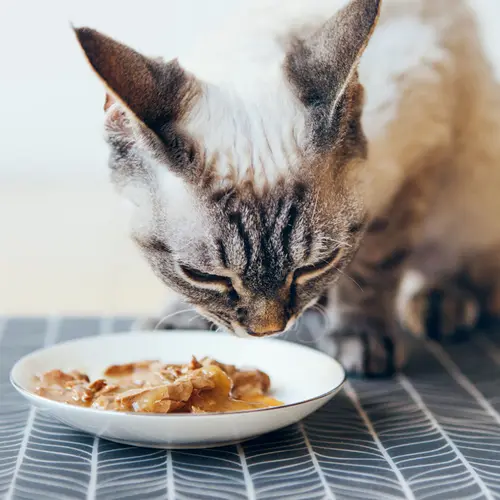Cats are susceptible to diseases caused by viruses. One common viral disease in cats is feline calicivirus (FCV). This disease is host-specific, meaning it can be spread to other cats but not to other animal species or to humans.
What Is Feline Calicivirus?
Feline calicivirus is a virus that causes disease in cats. FCV is highly contagious and can cause cats to develop mild to severe respiratory infections and oral diseases. This disease-causing virus is common in breeding colonies and shelters. Younger cats are at a higher risk of getting infected with feline calicivirus than older ones. A calicivirus infection is not directly treatable, although supportive care is possible, and most cats completely recover from this infection. But some rare strains (or types) of this virus can be deadly.
What Is Feline Calicivirus Disease?
FCV is a significant cause of highly contagious upper respiratory infections (URIs) in cats. URIs are commonly called "cat flu." FCV affects oral and respiratory tissues and causes diseases in cats worldwide.
FCV belongs to the Caliciviridae family. Viruses in this family can infect animals like birds, amphibians, reptiles, rabbits, and livestock. While feline calicivirus is not transmitted to humans, some viruses in the Caliciviridae family can infect humans. An example is norovirus, which is a common cause of acute gastroenteritis (inflammation of the stomach and intestines, commonly called “stomach flu”).
Although they are rare, mutant strains of FCV do exist. These strains can cause severe disease and damage to multiple organs or even death. Infection with these strains can cause hepatitis (inflammation of the liver), pneumonia, and bleeding from the nose. Although outbreaks of disease caused by mutant strains are rare, up to 50% of affected cats may die.
What Are the Symptoms of Feline Calicivirus?
The symptoms of FCV vary depending on the strain and may differ from cat to cat. Your cat can show these symptoms for a few days or weeks. Here are some of the common feline calicivirus symptoms:
Upper respiratory infection. An acute upper respiratory infection is the most common symptom of an FCV infection. Your cat may show signs of a cold, such as nasal discharge, sneezing, eye discharge, and sometimes drooling. In more severe cases, your cat may develop ulcers on the tongue and the lining of the mouth.
Other symptoms that your cat may show include lethargy, lack of appetite, fever, and lameness. Inflammations such as conjunctivitis can also occur. Cats of all ages may develop pneumonia, although it is more common in young kittens.
Gingivitis and stomatitis. FCV may cause chronic gingivitis (inflammation of the gums). FCV also causes stomatitis (inflammation of the mucous membranes in the mouth, commonly at the back of the mouth). Gingivitis can cause your pet to have thick, inflamed gums that make eating painful.
Gingivitis and stomatitis caused by FCV are commonly referred to as Feline Chronic Gingivostomatitis.
Limping syndrome. Sometimes young cats infected with FCV can develop arthritis (inflammation of the joints). During this period, your cat may be extremely uncomfortable. This symptom lasts only a few days. If the limping syndrome is caused by an FCV infection, your cat may also have signs of upper respiratory infection. Still, they often don't have URI signs.
Limping syndrome is usually associated with fever, and the lameness can shift quickly from one limb to the other.
If your cat has an FCV infection, their weakened immune system makes them vulnerable to bacterial infections. Your cat may also lose weight. Symptoms are usually more severe in younger kittens and older cats, and miscarriage may occur in pregnant cats.
What Is the Treatment for Feline Calicivirus?
There's currently no treatment for an FCV infection. Usually, your cat's immune system will fight the infection, and you can offer supportive care during this time. Your cat usually can recover at home, but severe infections may need intensive nursing care. Most cats recover completely from an FCV infection. Some cases will develop chronic stomatitis/gingivitis. In severe cases, your cat may need nursing care, intravenous fluid therapy, and nutritional support.
Since opportunistic bacterial infections are common in cats with FCV infections, your pet may need to be treated with antibiotics. In addition, nebulization or steam inhalation may help if your cat has severe nasal congestion. You can also keep your cat's nose clean by using saline nasal drops to clear the nasal passages. Your veterinarian may also prescribe drugs that break down mucus to help reduce congestion.
Your vet may prescribe non-steroidal anti-inflammatory drugs (NSAIDs) to help reduce mouth pain and inflammation and fever.
How Do You Prevent Feline Calicivirus?
One way to reduce the risk of FCV infection in your cat is through vaccination. Vaccines can't protect your pet against FCV entirely. But when you vaccinate your cat, the vaccine can help reduce the severity of an FCV infection if your cat is exposed.
If an infected cat lives in a colony of cats, you should isolate that cat because FCV infection is highly contagious. Ensure strict hygiene, use separate feeding bowls, and disinfect items with which the infected cat comes into contact. Always wash your hands carefully before tending to other cats and use a different (or disposable) apron.
If you bring a new cat home, isolate the newcomer from other cats for one to two weeks. During this period, watch for signs of disease.

